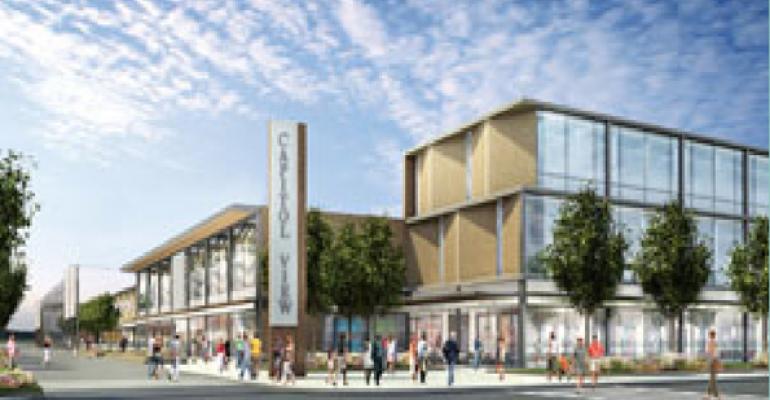Chicago-based Sears Holdings Corp. has been grabbing headlines recently more for its cost-cutting measures rather than new investment. But the struggling retailer is shifting gears with a proposed mixed-use redevelopment in St. Paul.
The company is proposing a comprehensive master-plan for its Sears store that sits on 14 acres at the edge of the central business district just blocks from the Minnesota State Capitol. The three-phase redevelopment project seizes on the opportunity to revitalize its aging St. Paul store and increase the density of the site by adding retail, office, a parking ramp and residential units.
A key catalyst to the project is the store’s location along the Central Corridor Light Rail Transit. The line, which starts at Target Field in Minneapolis, is in the process of being extended further into St. Paul near the Sears store with new stops at the Capitol and into Downtown St. Paul set to open in 2014.
"At our St. Paul property on Rice Street, we recognize the benefits of a transit-oriented development both to Sears as well as the surrounding community,” says Howard Riefs, a spokesperson for Sears Holdings. “We are enthusiastic about the completion of the nearby light-rail project and our vision for the property is a reflection of positive momentum in the downtown district.”

Sears has received preliminary design approval for phase one, which calls for the addition of about 110,000 sq. ft. of commercial space in two new buildings. The initial plan includes ground level retail with retail and/or office tenants above. Sears also plans to carve out two 5,000-sq.-ft. spaces on the south side of the Sears store for new retail tenants. The current store is about 186,000 sq. ft., and would be reduced to about two-thirds that size after the entire redevelopment is complete.
A future second phase would create a 112,000-sq.-ft. office building and a 500-plus-stall parking ramp, while a third phase would add 121 apartment units and nine townhome units.
“The Sears store is already an extremely profitable one for them,” says Paul Mandell, principal planner and zoning administrator for the Capitol Area Architectural and Planning Board in St. Paul. “I think by adding more retail around Sears it would re-energize the store as a destination.” The planning board provided preliminary approval for the phase one design concept in mid-January. The next step is for Sears to return with an application for full zoning approval.
The redevelopment is a new twist on Sears Holdings broader strategy to “unlock value” from its asset portfolio. For the most part, that has meant selling off owned stores and reducing its lease obligations. Through its strategy to trim its fixed costs—largely its real estate and inventory—Sears Holdings generated $1.8 billion in proceeds in 2012 as part of its ongoing asset reconfiguration, according to statements from the company. Specific to real estate, the company announced that it would close 120 stores in 2012. In addition, Sears Holdings has reduced its lease costs by $1 billion since 2010.
Such cost cutting is no surprise given the sizable task the chain is facing to boost profitability in the face of floundering sales. Since merging with Kmart in 2005, Sears Holdings has struggled to post sales growth. As a result, cutting fixed costs has been a key part of the company’s strategy to orchestrate a turnaround.
The company plans to continue that strategy in 2013 and it still has a considerable real estate portfolio to manage. Sears Holding owns roughly 200 million sq. ft. of real estate including 850 stores and about twice that number in leased stores. “We think they need to clean house on a bunch of stores to get to a level where the best stores can be re-invested in,” says Paul Swinand, an equity analyst at Morningstar Inc. in Chicago. That being said, it is still difficult to say whether that activity will be this year or if there will be a big year of closings in 2014, he adds.
Sears Holdings is exploring a variety of options to cut costs or create value in its real estate portfolio, whether that is entering into sales or sale-leasebacks, as well as closing stores or shrinking footprints by carving out space to give back to landlords or sublease to other tenants. “Every national retailer has to be doing that all the time or else their stores get old,” says Swinand. “If you let your store base go and don’t move, refurbish, redevelop, rethink all the time, eventually you start falling behind.”

